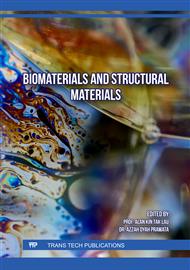[1]
J. Liu, B. Cao, and J. Yang, "Modelling intermetallic phase growth during high-power ultrasonic welding of copper and aluminum," J. Manuf. Process., vol. 35, p.595–603, 2018.
DOI: 10.1016/j.jmapro.2018.09.008
Google Scholar
[2]
E. Akca and A. Gürsel, "The importance of interlayers in diffusion welding - A review," Period. Eng. Nat. Sci., vol. 3, no. 2, p.12–16, 2015.
DOI: 10.21533/pen.v3i2.54
Google Scholar
[3]
H. Yu et al., "Phase analysis and corrosion behavior of brazing Cu/Al dissimilar metal joint with BAl88Si filler metal," Nanotechnol. Rev., vol. 10, no. 1, p.1318–1328, 2021.
DOI: 10.1515/ntrev-2021-0081
Google Scholar
[4]
C. Zhang and A. A. Shirzadi, "Diffusion bonding of copper alloy to nickel-based superalloy: effect of heat treatment on the microstructure and mechanical properties of the joints," Sci. Technol. Weld. Join., vol. 26, no. 3, p.213–219, 2021.
DOI: 10.1080/13621718.2021.1882653
Google Scholar
[5]
R. J. Smith, G. J. Lewis, and D. H. Yates, "Development and application of nickel alloys in aerospace engineering," Aircr. Eng. Aerosp. Technol., vol. 73, no. 2, p.138–146, 2001.
DOI: 10.1108/00022660110694995
Google Scholar
[6]
Z. Cheng, H. Liu, J. Huang, Z. Ye, J. Yang, and S. Chen, "MIG-TIG double-sided arc welding of copper-stainless steel using different filler metals," J. Manuf. Process., vol. 55, p.208–219, 2020.
DOI: 10.1016/j.jmapro.2020.04.013
Google Scholar
[7]
W. S. Shin et al., "Investigation on laser welding of al ribbon to cu sheet: Weldability, microstructure, and mechanical and electrical properties," Metals (Basel)., vol. 11, no. 5, 2021.
DOI: 10.3390/met11050831
Google Scholar
[8]
J. Zhang, Q. Shen, G. Luo, M. Li, and L. Zhang, "Microstructure and bonding strength of diffusion welding of Mo/Cu joints with Ni interlayer," Mater. Des., vol. 39, p.81–86, 2012.
DOI: 10.1016/j.matdes.2012.02.032
Google Scholar
[9]
H. Sabetghadam, A. Zarei Hanzaki, A. Araee, and A. Hadian, "Microstructural evaluation of 410 SS/Cu diffusion-bonded joint," J. Mater. Sci. Technol., vol. 26, no. 2, p.163–169, 2010.
DOI: 10.1016/S1005-0302(10)60027-8
Google Scholar
[10]
H. Sabetghadam, A. Z. Hanzaki, and A. Araee, "Diffusion bonding of 410 stainless steel to copper using a nickel interlayer," Mater. Charact., vol. 61, no. 6, p.626–634, 2010.
DOI: 10.1016/j.matchar.2010.03.006
Google Scholar
[11]
D. Kim, J. H. Chang, J. Park, and J. J. Pak, "Formation and behavior of Kirkendall voids within intermetallic layers of solder joints," J. Mater. Sci. Mater. Electron., vol. 22, no. 7, p.703–716, 2011.
DOI: 10.1007/s10854-011-0357-2
Google Scholar


